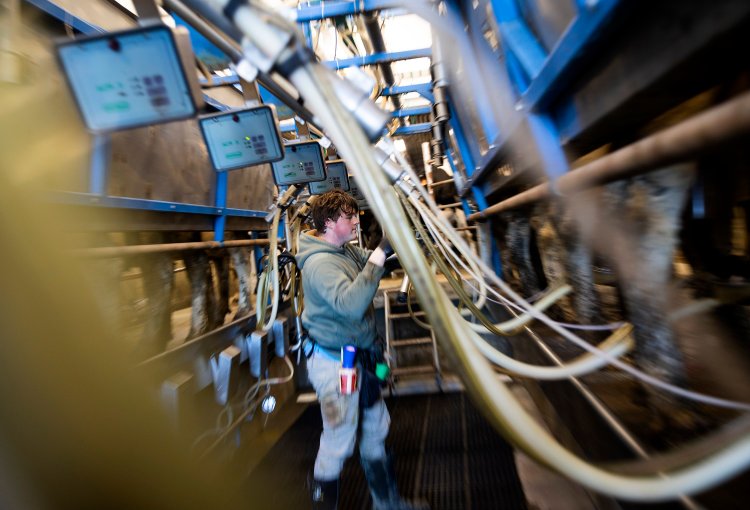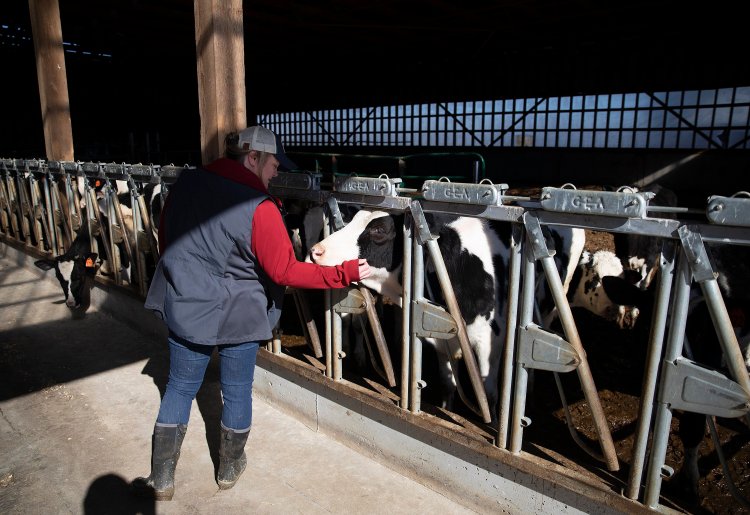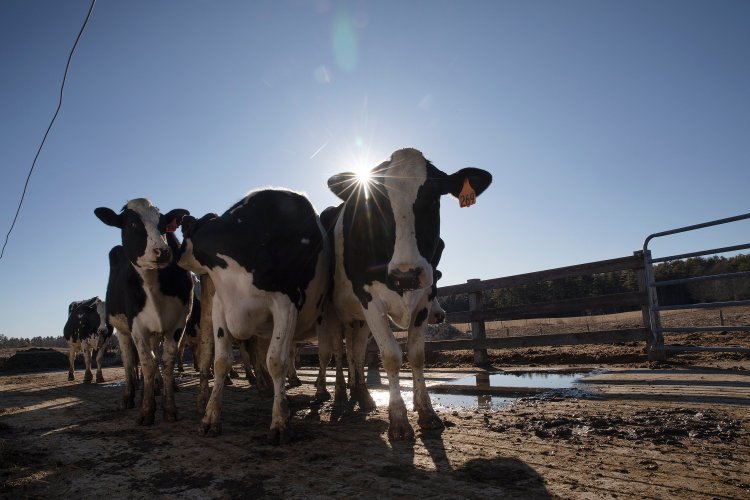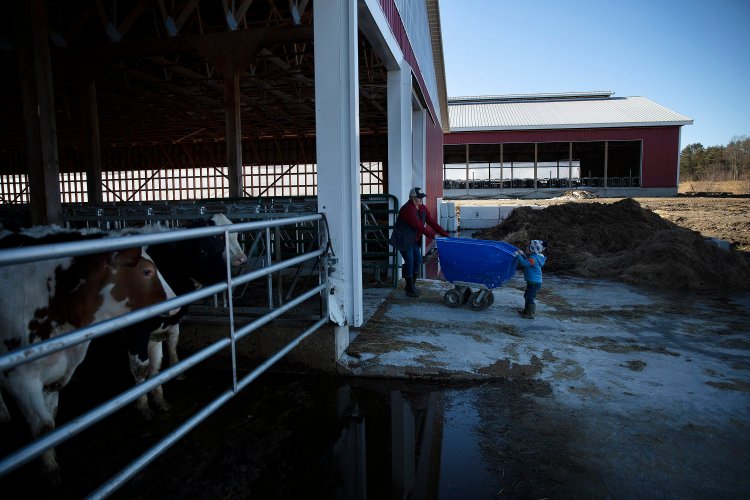
Maine has lost one-third of its commercial dairy farms since 2020, leaving 145 conventional and organic dairy farmers struggling to operate amid rising costs, shifting market forces and climate change.
The decline is happening nationally, with 1,600 dairy farms shutting down across the United States last year, according to the U.S. Department of Agriculture. Hardest hit were Michigan, Wisconsin and Pennsylvania.
To help stem the losses in Maine, Gov. Janet Mills signed emergency legislation last week to set up a task force that will study the challenges facing the state’s commercial dairy farmers and recommend ways to support the long-term sustainability of the industry by the start of next year.
Annie Watson and Mike Moody have witnessed the attrition first hand since they took over Sheepscot Valley Farm, an organic dairy in Whitefield where they milk 75 Holsteins at the crack of dawn and before sunset each day.
John Batchelder, 17, of Vassalboro, milks cows at Sheepscot Valley Farm, an organic dairy farm in Whitefield. Derek Davis/Staff Photographer
Buy Image
Watson, who is president of the Maine Dairy Industry Association, recently testified before the Legislature’s agriculture committee about the challenges facing the state’s dairy farmers. She spoke in support of a pending $4 million budget appropriation to the state’s milk price stabilization program, a subsidy unique to Maine that closes the gap between production costs and market prices.
“In the 11 years we have owned and operated Sheepscot Valley Farm, we have seen the dairy markets change, the players in the industry change and the landscape around us change,” Watson told the packed committee room.
The subsidy program has saved many dairies, Watson said, but even so, the number of farms producing milk in Maine has dropped 52%, from 304 to 145, since 2010, according to the Maine Milk Commission.
“Nobody wants to be in this position, asking for help,” Watson explained later. “Farmers are a hardy, independent lot. To admit we need a subsidy, it’s hard. But our cost of production has risen so drastically.”
Lawmakers crafted the emergency bill to study Maine’s dairy industry in response to the concerns Watson and others raised during talks about the milk subsidy program. Amanda Beal, head of the Maine Department of Agriculture, Conservation and Forestry, will spearhead the task force and produce “robust recommendations” that will keep the state’s dairy industry strong for decades to come, Mills said in a statement.
Annie Watson pets one of her Holsteins at Sheepscot Valley Farm. Derek Davis/Staff Photographer
Buy Image
“For generations, hardworking Maine dairy farmers have contributed to our economy, sustained our rural communities, and helped to feed Maine people with healthy, high-quality dairy products,” Mills said. “In recent years, labor shortages, inflation, supply chain disruptions and other challenges have made the operation of commercial dairy farms incredibly difficult for too many farmers across Maine and the nation.”
Introduced by the agriculture committee, the bill passed both houses unanimously. The task force is directed to report its findings by January 2025. The committee is expected to introduce legislation based on the findings that year.
“Agriculture is a heritage industry in Maine and dairy is one of the biggest sectors in agriculture,” said Sen. Craig Hickman, D-Winthrop, an organic farmer who is Senate chair of the committee. “We want to find out what’s happening in the dairy industry and do what we can to support it.”
Rep. Bill Pluecker, I-Warren, House chair of the committee, already has some ideas on how to boost Maine’s dairy industry.
“Everybody is kind of panicked,” Pluecker said. “People aren’t drinking as much milk as they used to, and much of the milk that’s being produced in Maine is going out of state. We need to create home-grown processing facilities for butter, cream, cheeses and other dairy products.”
With increasing competition from plant-based milks and bottled waters, Americans are drinking less milk than they used to, down from about 1 cup daily per person in 1970 to less than ½ cup today, according to the USDA. Still, milk is the most consumed dairy product, followed by cheese, frozen dairy products and yogurt.
Some of the Holsteins at Sheepscot Valley Farm wait to go back to their barn after milking. Derek Davis/Staff Photographer
Buy Image
At the same time, U.S. milk production has increased 96% since 1975, reaching a high of 226.6 billion pounds in 2023. That’s 26.4 billion gallons, because 100 pounds of milk equals 11.6 gallons.
And while the number of commercial dairy farms in Maine has fallen 78% from 674 operations in 1990 to 145 today, milk production is down only 8%, from 584 million pounds in 1990 to 538 million pounds in 2023.
Two years ago, Horizon Organic jolted the industry when the Colorado-based company announced it would stop buying milk from producers in the Northeast, including 14 Maine dairy farms.
Watson, the Whitefield dairy farmer, ticks off a list of challenges facing Maine dairy farmers that sounds similar to many businesses these days: inflation, labor pressures, energy costs and trucking costs.
“Maine is at the end of the line,” Watson said. “Shipping in and out is a big driver of our costs.”
More specific to farming, trucking feed from out of state is a major expense, especially when increasingly unpredictable weather leaves hay crops rotting in the field, as it did last year, she said. Sheepscot Valley Farm practices rotational grazing and raises hay on its 120 acres and an additional 275 acres nearby.
Annie Watson gets some help from her youngest son, Guthrie, 3, at Sheepscot Valley Farm. Derek Davis/Staff Photographer
Buy Image
Agribusiness and the consolidation of dairy producers and processors has limited where Maine dairies can sell their milk, and many options are now out of state, Watson said.
“It limits the opportunities available for our local agricultural markets,” Watson said, “and we saw during COVID how precious our local food supply is.”
But Watson and others say there’s a lot more at stake than being able to buy local dairy products.
Dairy farms are the backbone of Maine’s rural economy, she said, supporting feed stores, equipment companies, veterinarians and other related businesses. They also preserve open space, often for public recreation. And dairy farmers are some of the hardest working people you’ll ever meet.
“There are easier ways to go broke than turning grass into milk,” Watson said.
You can now read the most important #news on #eDairyNews #Whatsapp channels!!!
🇺🇸 eDairy News INGLÊS: https://whatsapp.com/channel/0029VaKsjzGDTkJyIN6hcP1K





























